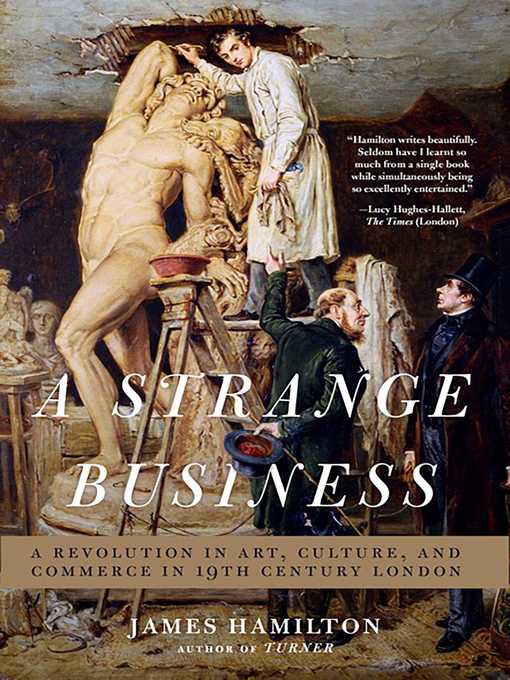
A Strange Business
- اطلاعات
- نقد و بررسی
- دیدگاه کاربران
نقد و بررسی

Starred review from June 1, 2015
A noted historian weaves a brilliantly colorful tapestry. From 1800, when George III still ruled, until the end of Victoria's reign in 1901, Britain experienced dramatic social, political, economic, and cultural changes, resulting from the advent and expansion of the Industrial Revolution. Art historian and biographer Hamilton (University Curator and Honorary Reader in the History of Art/Univ. of Birmingham; London Lights: The Minds that Moved the City that Shook the World, 2007, etc.) offers an enthralling, densely detailed examination of the impact of these changes on the art world, populating his narrative with more than 150 painters, sculptors, dealers, collectors, engravers, publishers, writers, architects, and providers of artists' materials, such as chemists (who created colors), suppliers of marble, and manufacturers of pen nibs. It's likely that many of his huge cast of characters will not be familiar to readers, but Hamilton's deft portraits bring them to life: Benjamin Robert Haydon, "vain, debt-ridden, self-destructive," who insisted on painting historical narratives at a time when that genre was on the wane; the "charming, generous, loving" John Varley, a venerated teacher and popular watercolorist, whose financial woes landed him in debtors prison; the indomitable Maria Graham, a multilingual explorer of "untrodden paths," whose marriage to artist Augustus Wall Callcott allowed her to reinvent herself "as an influential opinion-former and a distinguished, gregarious, and independent woman of letters." Hamilton gives prominence to his former biographical subjects J.M.W. Turner, a savvy and successful marketer of his works; and Michael Faraday, who improved image reproduction of steel-plate engraving and lithography and contributed to the creation of a new paint color, Prussian blue. The book is organized according to participants' roles, which include not only creators of art, but also the patrons who supported them, the dealers who exhibited and sold their works, and the engravers who reproduced their work for mass consumption. A fascinating, consistently entertaining exploration into the exploding business of 19th-century art.
COPYRIGHT(2015) Kirkus Reviews, ALL RIGHTS RESERVED.

July 1, 2015
Art historian Hamilton (Turner: A Life) describes a complex world of art, business, reputation, and value and how these four concepts are woven into the everyday lives of artists and artisans, collectors, dealers, entrepreneurs, inventors, publishers, and others who struggled with changing mores of society and fashion in 19th-century London. The author skillfully places readers in the middle of the action of intrigue, rivalries, friendships, networks, and business transactions. The opening two chapters deal with the evolution of an old and new style of patrons and patronage; the following sections focus on the realms of painter, sculptor, dealer, "colourman," engraver, publisher, curator, and spectator. The closing segment culminates in the creation of the Crystal Palace and how it changed art and exhibition. Two sections of illustrative plates display the art and activities of the time. Also included is a list of "Dramatis Personae" that offers the names, dates, and areas of specialty of the men and women whose lives intersect with the text. VERDICT This refreshing account of the London art scene of yesteryear should be a part of collections of every type and will be of interest to historians and enthusiasts of the period.--Stephen Allan Patrick, Jonesborough, TN
Copyright 2015 Library Journal, LLC Used with permission.

September 1, 2015
Art, business, reputation, and value are the four boisterous creatures at the center of Hamilton's joyful review of the British arts industrial revolution of the nineteenth century. This fascinating history positions itself as the original art world expose, charting the groundbreaking shift in the 1800s from traditional cultural patronage to a furious commercial art market driven by an influx of new money, new middle-class audiences, and new technical innovation. With chapters organized around evolving art world roles ( Dealer, Publisher, Curator, etc.), Hamilton offers anecdotal art histories of backroom deals, contract disputes, and savvy investments. These stories, rich in quoted correspondence and financial figures, paint a vivid picture of the complex social and institutional structures of London's rising entrepreneurial class, and its ambitious leveraging of art for both economic and social gain. The text presents particularly compelling arguments for the ways in which growing professionalism in engraving and pigment science led to increased commercial reproduction and crowd-pleasing image vibrancy (think J. M. W. Turner's dripping yellow sunsets) that shifted the era's art and artists firmly into the capitalist economy.(Reprinted with permission of Booklist, copyright 2015, American Library Association.)




دیدگاه کاربران